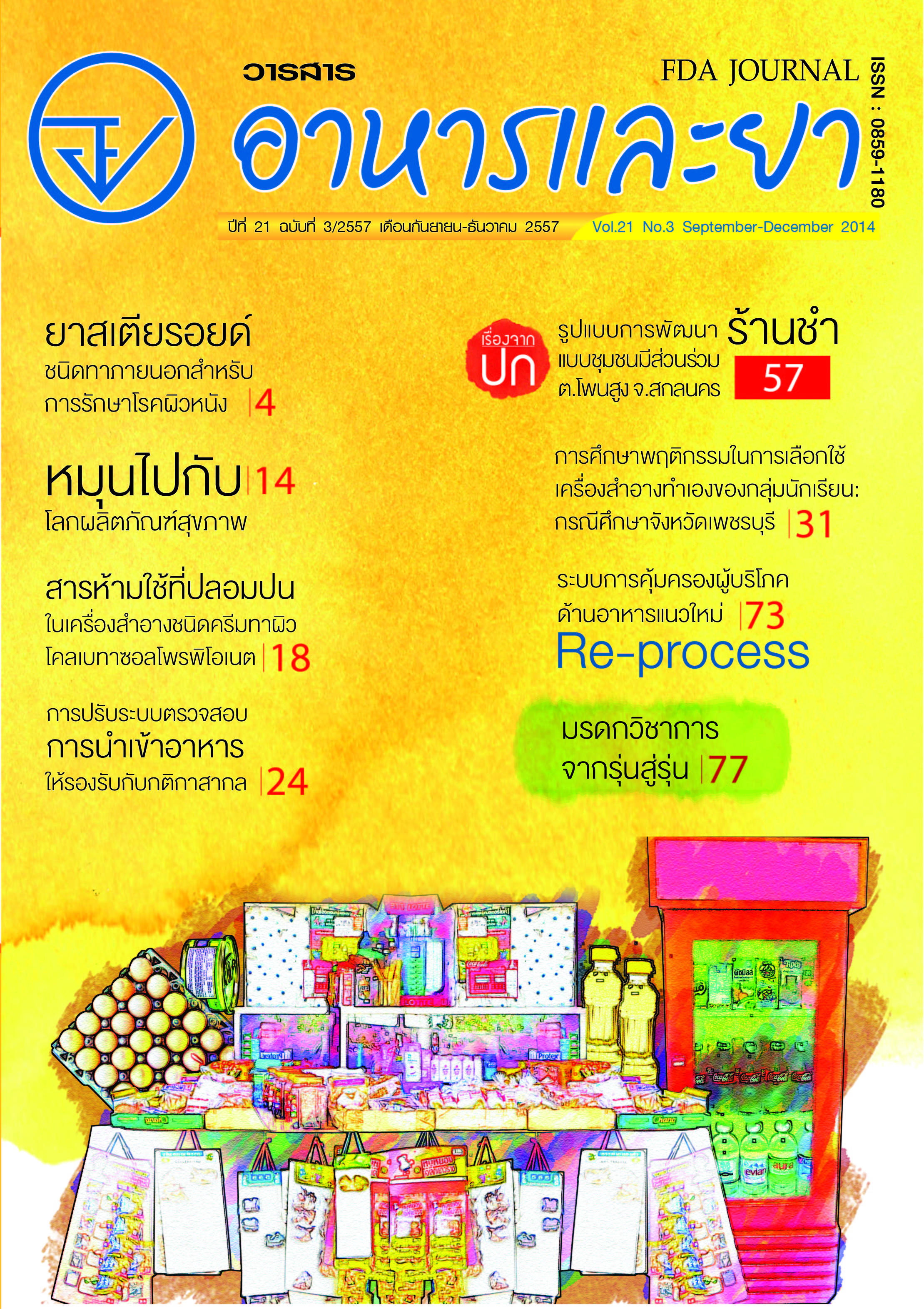โครงการสำรวจการปนเปื้อนสารสเตียรอยด์ในยาแผนโบราณใน 9 จังหวัด
Main Article Content
บทคัดย่อ
การศึกษานี้มีวัตถุประสงค์เพื่อติดตามสถานการณ์การปนเปื้อนสารสเตียรอยด์ในยาแผนโบราณที่
ไม่มีเลขทะเบียนยาหรือไม่ทราบแหล่งผลิตใน 9 จังหวัด ในเขตความรับผิดชอบของศูนย์วิทยาศาสตร์การแพทย์ที่ 6
ชลบุรี และวิเคราะห์ปริมาณเดกซาเมทาโซนและเพรดนิโซโลนในยาแผนโบราณ ในระหว่างเดือนตุลาคม 2554
ถึง กันยายน 2556 ศูนย์วิทยาศาสตร์การแพทย์ที่ 6 ชลบุรี ท
ําาการเก็บตัวอย่างยาแผนโบราณที่ไม่มีเลขทะเบียนยา
จําานวน 67 ตัวอย่าง จากตลาดนัด แผงลอย ร้านค้าทั่วไปในเขตรับผิดชอบ จําานวน 9 จังหวัด ได้แก่ ชลบุรี
ระยอง จันทบุรี ตราด สมุทรปราการ ฉะเชิงเทรา สระแก้ว นครนายก และปราจีนบุรี รวมทั้งได้รับตัวอย่าง
จําานวน 32 ตัวอย่างจากหน่วยงานสาธารณสุขเครือข่าย ผลการวิเคราะห์พบยาแผนโบราณที่มีเดกซาเมทาโซน
ปนอยู่ 24 ตัวอย่าง และมียาแผนโบราณที่ปนเพรดนิโซโลน 12 ตัวอย่าง เมื่อน
ําาตัวอย่างที่ตรวจพบสารสเตียรอยด์
ซึ่งมีปริมาณตัวอย่างมากพอจ
ําานวน 12 ตัวอย่าง มาตรวจวิเคราะห์หาปริมาณสารสเตียรอยด์ด้วยวิธี HPLC
พบว่า มีปริมาณเพรดนิโซโลน 0.10–2.58 มิลลิกรัมต่อมื้อ มีปริมาณเดกซาเมทาโซน 0.10–1.35 มิลลิกรัมต่อมื้อ
ซึ่งเทียบใกล้เคียงกับการบริโภคยาเม็ดเดกซาเมทาโซน มื้อละเศษหนึ่งส่วนสี่เม็ด ถึง 3 เม็ด โดยมีตัวอย่าง
ยาแผนโบราณ 8 ตัวอย่าง เมื่อค
ําานวณการบริโภคต่อวันแล้วจะมีปริมาณเดกซาเมทาโซนมากกว่า 0.75
มิลลิกรัม ซึ่งอาจท
ําาให้เกิดอันตรายต่อร่างกายหากใช้เป็นระยะเวลานานโดยไม่มีข้อบ่งใช้ทางการแพทย์ โดยเฉพาะ
อย่างยิ่งผู้ที่มีปัญหาทางสุขภาพอยู่ก่อนแล้ว อาจทําาให้เกิดผลรุนแรง และอาจถึงขั้นเสียชีวิตได้
ไม่มีเลขทะเบียนยาหรือไม่ทราบแหล่งผลิตใน 9 จังหวัด ในเขตความรับผิดชอบของศูนย์วิทยาศาสตร์การแพทย์ที่ 6
ชลบุรี และวิเคราะห์ปริมาณเดกซาเมทาโซนและเพรดนิโซโลนในยาแผนโบราณ ในระหว่างเดือนตุลาคม 2554
ถึง กันยายน 2556 ศูนย์วิทยาศาสตร์การแพทย์ที่ 6 ชลบุรี ท
ําาการเก็บตัวอย่างยาแผนโบราณที่ไม่มีเลขทะเบียนยา
จําานวน 67 ตัวอย่าง จากตลาดนัด แผงลอย ร้านค้าทั่วไปในเขตรับผิดชอบ จําานวน 9 จังหวัด ได้แก่ ชลบุรี
ระยอง จันทบุรี ตราด สมุทรปราการ ฉะเชิงเทรา สระแก้ว นครนายก และปราจีนบุรี รวมทั้งได้รับตัวอย่าง
จําานวน 32 ตัวอย่างจากหน่วยงานสาธารณสุขเครือข่าย ผลการวิเคราะห์พบยาแผนโบราณที่มีเดกซาเมทาโซน
ปนอยู่ 24 ตัวอย่าง และมียาแผนโบราณที่ปนเพรดนิโซโลน 12 ตัวอย่าง เมื่อน
ําาตัวอย่างที่ตรวจพบสารสเตียรอยด์
ซึ่งมีปริมาณตัวอย่างมากพอจ
ําานวน 12 ตัวอย่าง มาตรวจวิเคราะห์หาปริมาณสารสเตียรอยด์ด้วยวิธี HPLC
พบว่า มีปริมาณเพรดนิโซโลน 0.10–2.58 มิลลิกรัมต่อมื้อ มีปริมาณเดกซาเมทาโซน 0.10–1.35 มิลลิกรัมต่อมื้อ
ซึ่งเทียบใกล้เคียงกับการบริโภคยาเม็ดเดกซาเมทาโซน มื้อละเศษหนึ่งส่วนสี่เม็ด ถึง 3 เม็ด โดยมีตัวอย่าง
ยาแผนโบราณ 8 ตัวอย่าง เมื่อค
ําานวณการบริโภคต่อวันแล้วจะมีปริมาณเดกซาเมทาโซนมากกว่า 0.75
มิลลิกรัม ซึ่งอาจท
ําาให้เกิดอันตรายต่อร่างกายหากใช้เป็นระยะเวลานานโดยไม่มีข้อบ่งใช้ทางการแพทย์ โดยเฉพาะ
อย่างยิ่งผู้ที่มีปัญหาทางสุขภาพอยู่ก่อนแล้ว อาจทําาให้เกิดผลรุนแรง และอาจถึงขั้นเสียชีวิตได้
Article Details
รูปแบบการอ้างอิง
1.
อัครวรัณธร จ, กิจไชยา ศ. โครงการสำรวจการปนเปื้อนสารสเตียรอยด์ในยาแผนโบราณใน 9 จังหวัด. TFDJ [อินเทอร์เน็ต]. 8 สิงหาคม 2018 [อ้างถึง 26 ธันวาคม 2025];21(3):64-72. available at: https://he01.tci-thaijo.org/index.php/fdajournal/article/view/139074
ประเภทบทความ
รายงานการวิจัย


